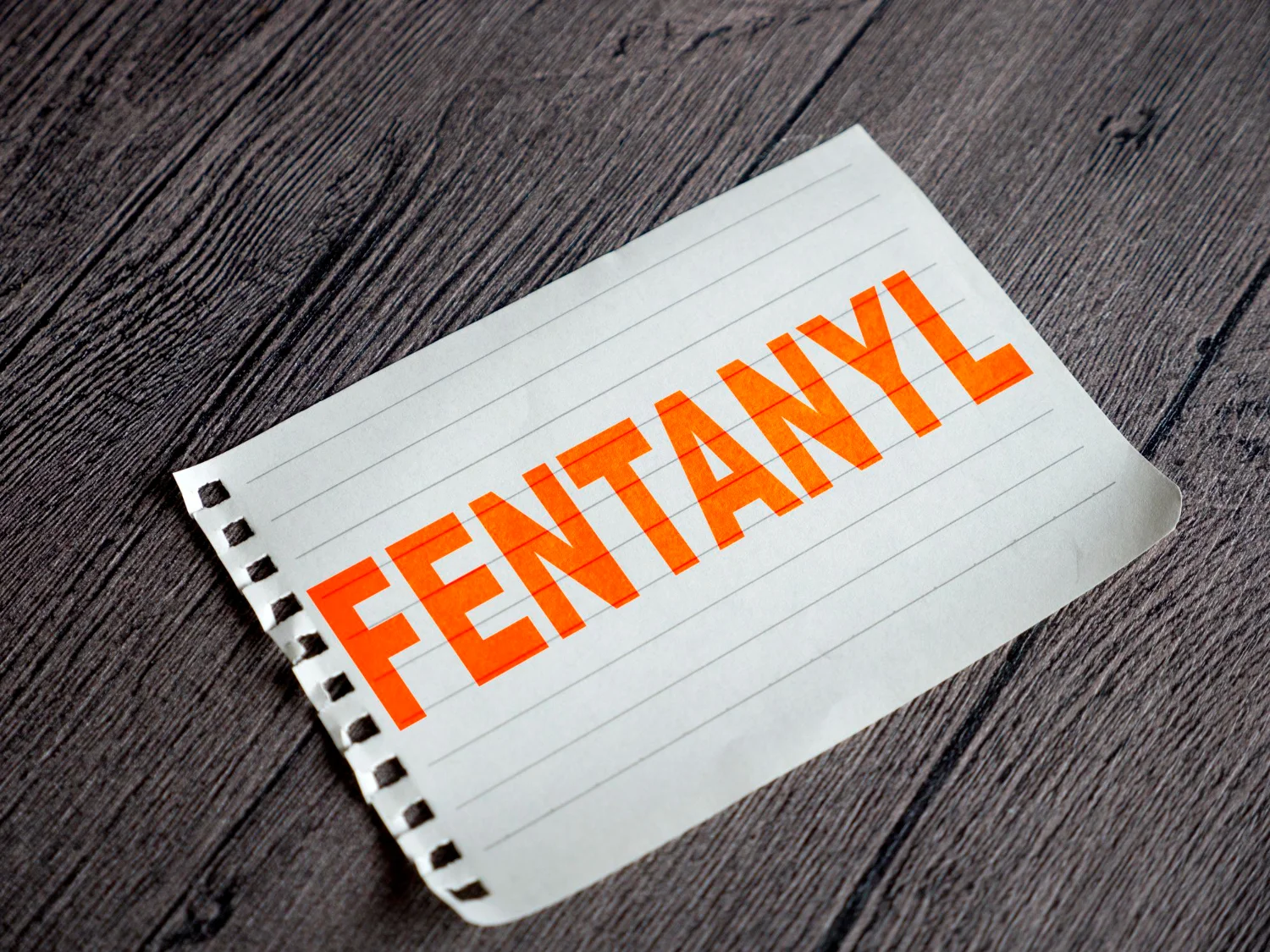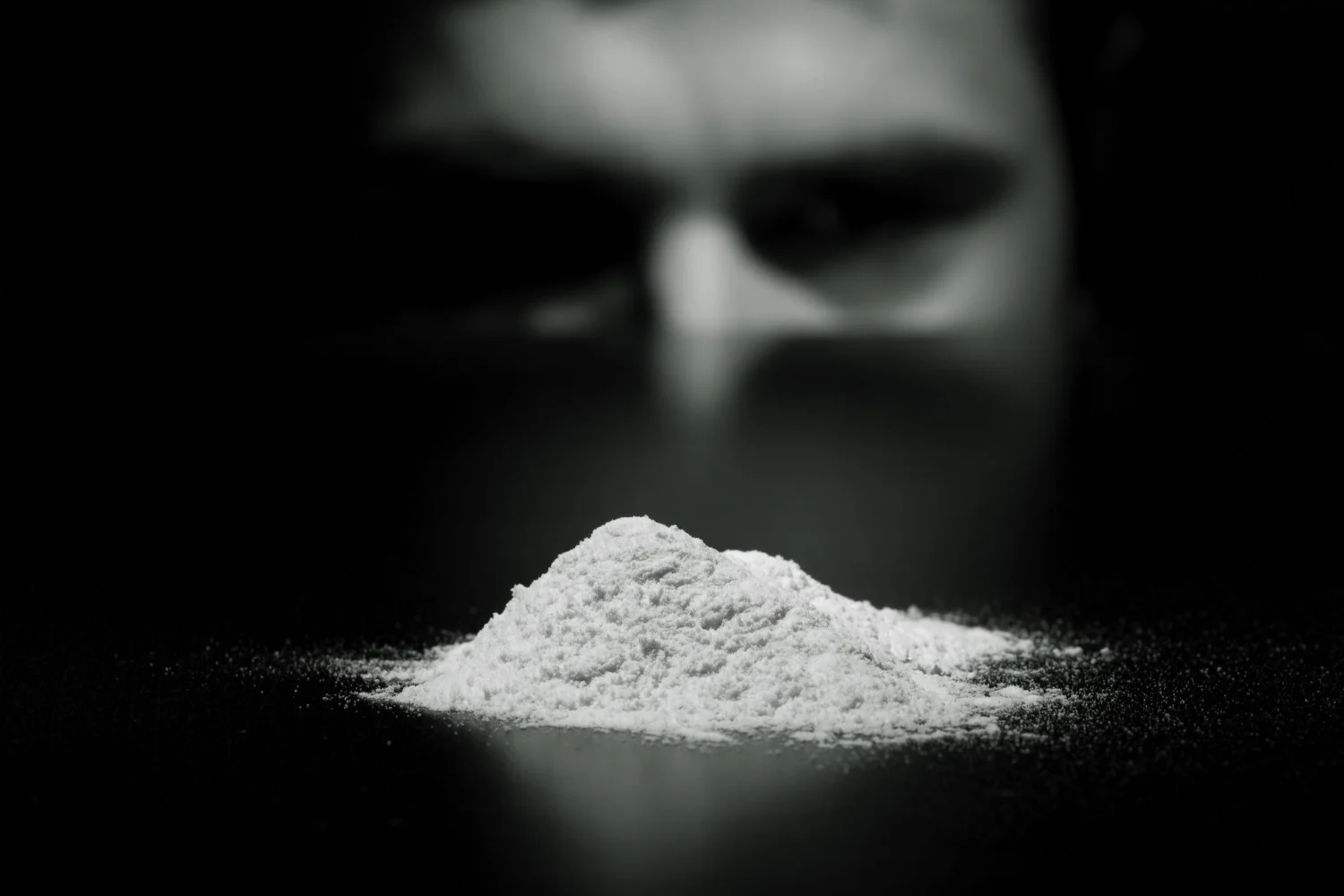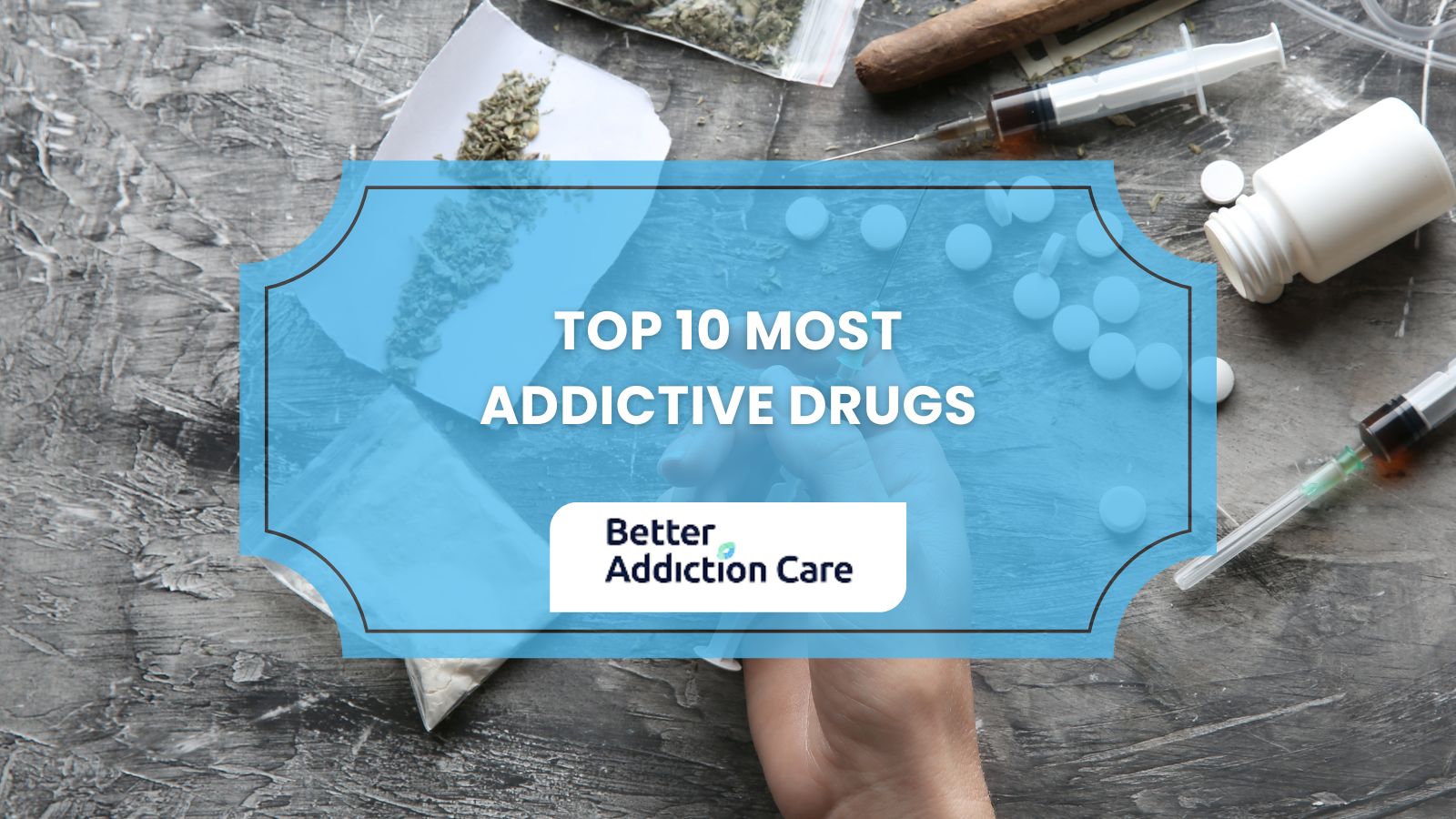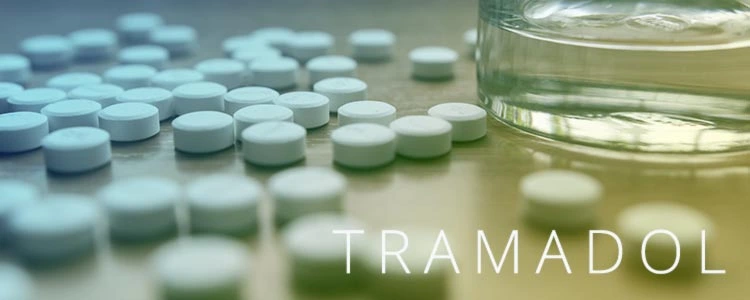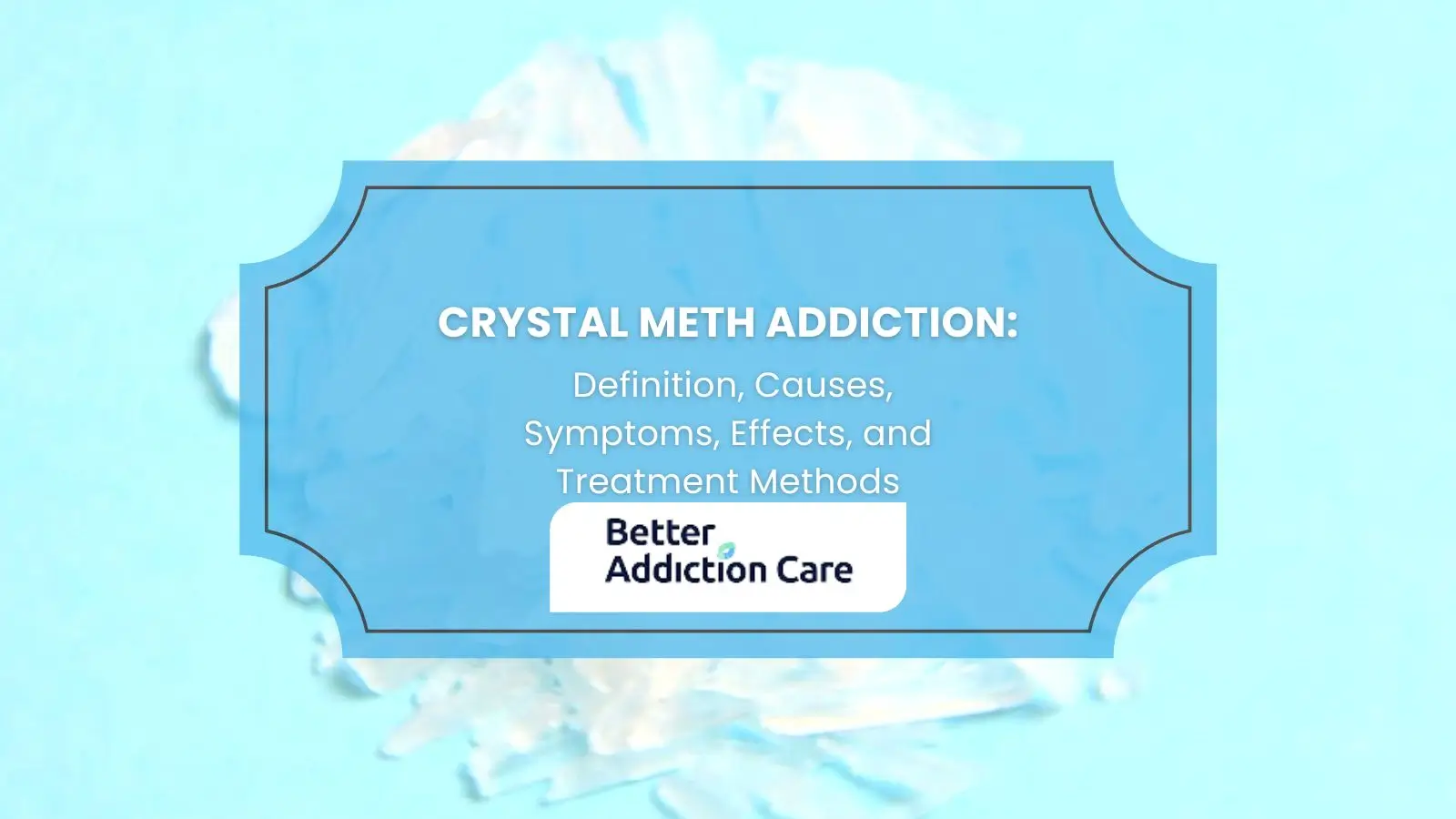Heroin Addiction: Definition, Causes, Symptoms, and Treatment
Heroin addiction is a chronic condition where people become dependent on heroin, an opioid that affects the brain's reward system, leading to intense cravings and compulsive drug use.
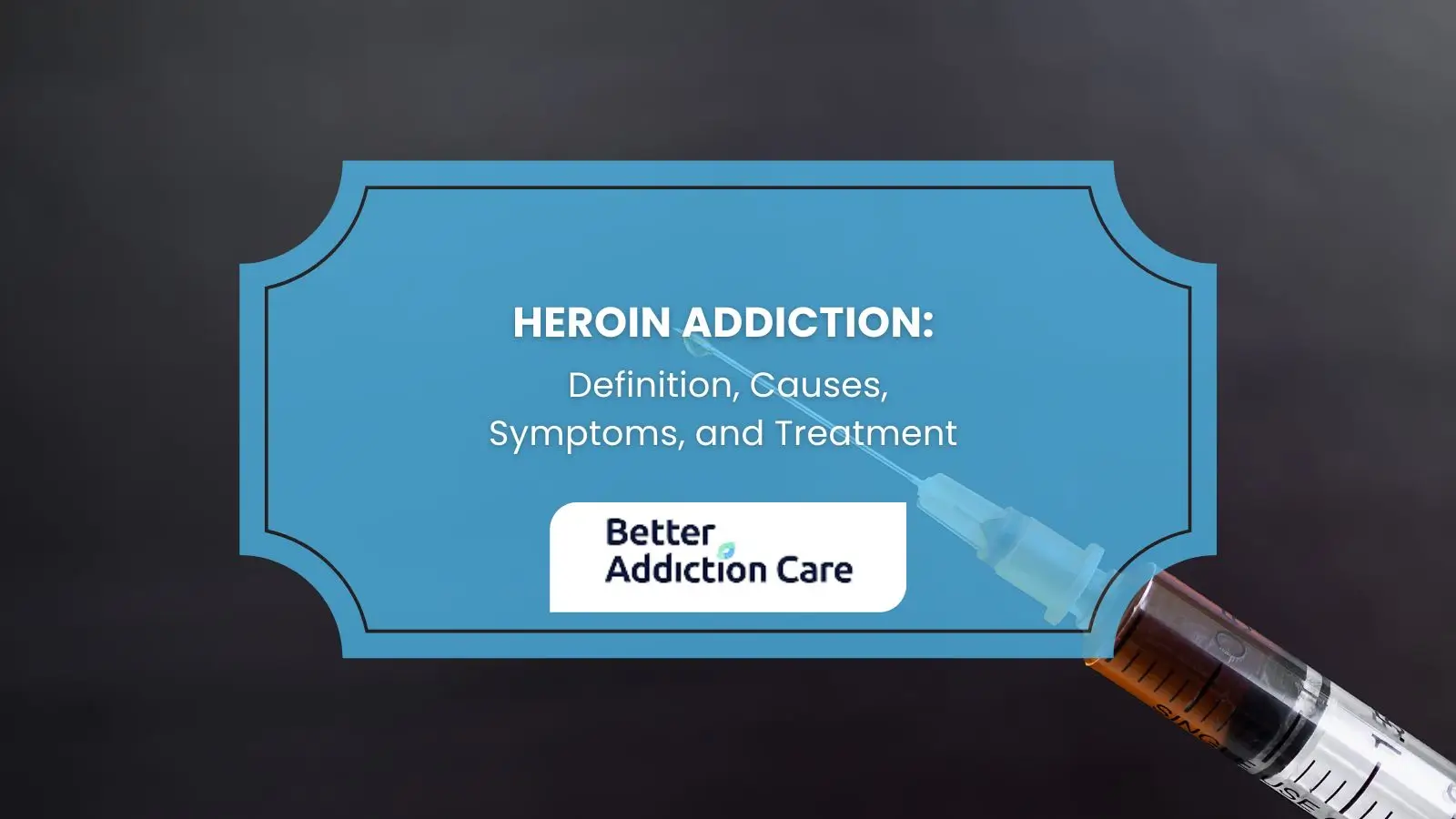
Heroin addiction is a chronic condition where people become dependent on heroin, an opioid that affects the brain's reward system, leading to intense cravings and compulsive drug use.
The main causes of heroin addiction include genetic factors, mental health issues like depression or anxiety, and environmental influences such as peer pressure or exposure to drug use. People who misuse prescription opioids are also at a higher risk of turning to heroin.
Symptoms of heroin addiction include extreme drowsiness, weight loss, mood swings, and neglect of personal responsibilities. Physical signs like small pupils and frequent nausea also indicate addiction.
Treatment for heroin addiction usually combines medication-assisted therapy with other forms of support like counseling and therapy. Medications like methadone or buprenorphine help manage withdrawal symptoms and reduce cravings. Counseling and behavioral therapy address the underlying psychological causes of addiction. Support groups provide an essential network, helping individuals maintain long-term recovery and avoid relapse.
What is Heroin Addiction?
Heroin addiction is a chronic, relapsing disorder characterized by compulsive drug use regardless of harmful consequences, driven by the misuse of heroin, an opioid derived from morphine. Heroin activates opioid receptors in the brain, producing a euphoric rush and sedation, which quickly leads to dependence as the brain's reward system is hijacked according to the National Institute on Drug Abuse (NIDA) research titled “What effects does heroin have on the body?”. Users experience a powerful surge of pleasure followed by relaxation, leading them to seek repeated doses to maintain the high. This pattern fuels addiction, resulting in both tolerance and withdrawal symptoms.
Globally, around 60.4 million people use opioids, with 31.5 million primarily using heroin. In the U.S., approximately 745,000 people used heroin in 2019, with nearly 14,000 overdose deaths related to heroin that year according to the National Center For Drug Abuse Statistics,. Heroin use increased between 2019 and 2020, with about 902,000 Americans using heroin annually and 103,000 starting each year. In particular 80% of heroin users first misused prescription opioids. Heroin accounts for 1.5% of all illicit drug use among Americans aged 12 or older annually, with 4.5% having used it in their lifetime. Approximately 6.25 million Americans will use heroin at least once in their lifetime.
Heroin overdose deaths have surged in the U.S. since 2010. Between 2012 and 2014, the rate nearly doubled, and since 2014, it has remained in the tens of thousands. Annually, 14,019 people die from heroin overdoses, with the death rate increasing by over 10,000 people in the past decade. Furthermore, 8,746 die from heroin combined with synthetic opioids, and 5,273 die from heroin alone. This equals to 2.7 deaths per 100,000 people from heroin with synthetic opioids, and 1.7 deaths per 100,000 from heroin alone.
What are the Methods of Heroin Use?
The methods of heroin use are through injection, smoking, snorting, and oral consumption. Injection involves using a syringe to transfer the drug directly into the bloodstream, providing an immediate and intense high. Smoking heroin, often referred to as chasing the dragon, involves heating the drug on foil and inhaling the vapor, which produces a rapid outbreak of effects. Snorting heroin involves crushing the drug into a powder and inhaling it through the nose, leading to a quicker effect than oral consumption but not as fast as injection. Oral consumption involves swallowing the drug in pill or powder form, which results in a gradual arrival of effects. Each method carries its own risks, including increased potential for addiction and health complications.
What is the Duration of Heroin in the Body?
The duration of heroin in the body is short and lasts for 2 to 6 minutes after injection before it is metabolized into 6-acetylmorphine and morphine, which remain detectable for a longer period. Heroin itself is generally detectable in blood for up to 6 hours, in saliva for up to 24 hours, in urine for up to 3 days, and in hair for up to 90 days according to research titled “How Long Does Heroin Stay in Your System?” published by Renaissance Recovery,. The detection window varies based on factors like the method of consumption, frequency of use, and an individual's metabolism. Heroin metabolizes quickly according to research published in the National Library of Medicine,” PubChem”. The breakdown products may stay in the system and be detected in various drug tests, with morphine often being the primary marker for heroin use.
What are the Causes of Heroin Addiction?
The causes of heroin addiction include biological factors, environmental influences, psychological factors, the use of prescription opioids, and self-medication.
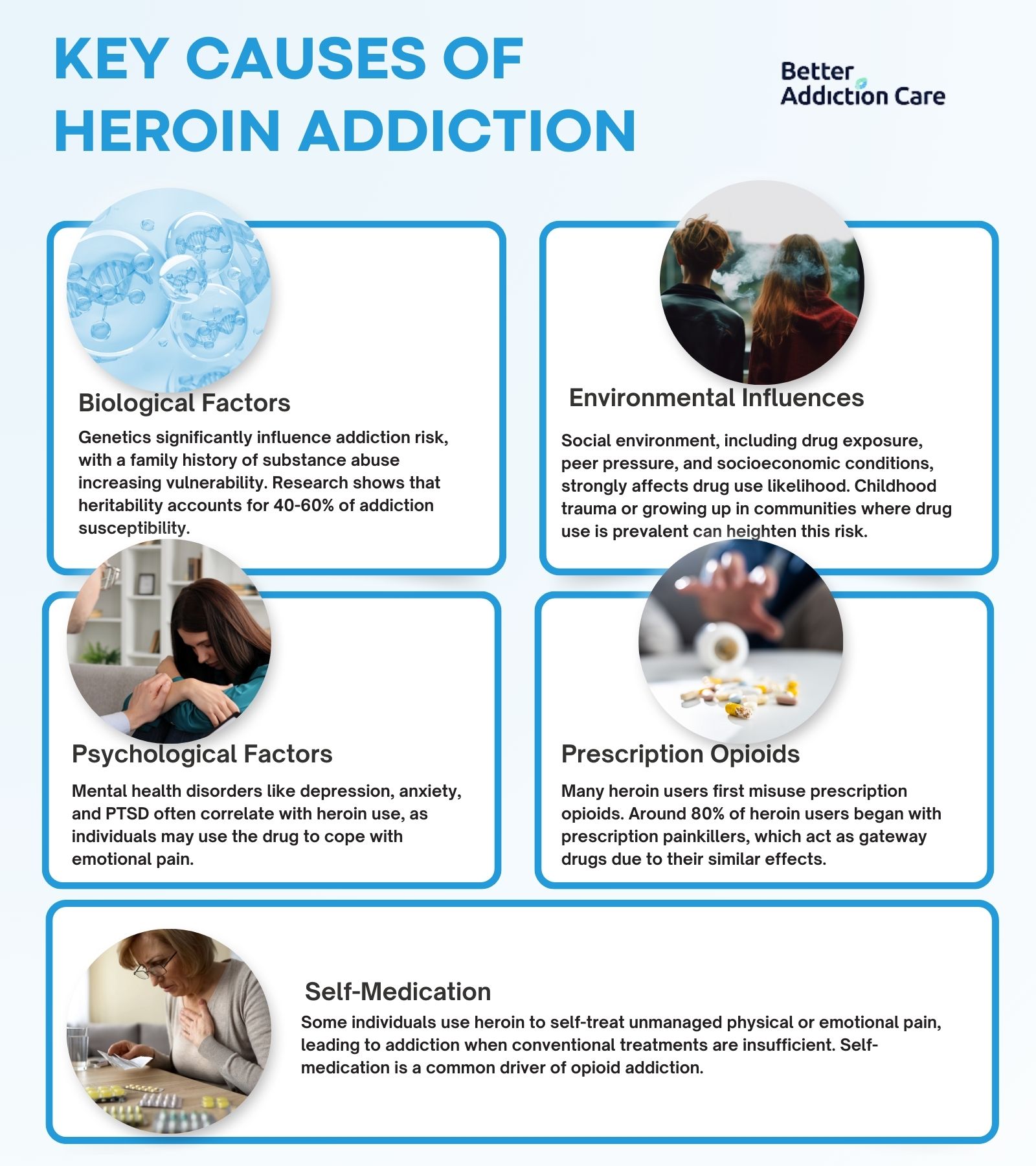
Details of these causes are below.
-
Biological Factors: Biological factors like genetics play a significant role in addiction vulnerability, according to the research published in the National Library of Medicine. Individuals with a family history of addiction are at higher risk of developing substance abuse disorders, including heroin addiction. Heritability accounts for 40-60% of the variability in addiction development within the population according to the research titled “Understanding the genetics and neurobiological pathways behind addiction (Review)”.
-
Environmental Influences: A person’s environment, including exposure to drugs, peer pressure, and socioeconomic status, significantly influences drug use. Growing up in a community where drug use is prevalent or experiencing trauma in childhood are strong predictors of future substance abuse according to research Understanding Drug Use and Addiction DrugFacts.
-
Psychological Factors: Psychological factors and mental health disorders such as depression, anxiety, and post-traumatic stress disorder (PTSD) are often linked to heroin addiction, according to a study published by the National Institute of Mental Health. People with these conditions may turn to heroin as a means of coping with emotional pain. There is a high correlation between mood disorders and opioid abuse.
-
Use of Prescription Opioids: Many heroin users start by misusing prescription opioids. Approximately 80% of heroin users reported first misusing prescription painkillers, which act as gateway drugs due to their similar effects according to the study published by the National Institute on Drug Abuse titled “Prescription Opioids and Heroin Research Report Prescription opioid use is a risk factor for heroin use”.
-
Self-Medication: Some individuals turn to heroin as a way to self-medicate untreated physical pain or emotional distress according to the research titled “Self-Help Groups and Medication Use in Opioid Addiction Treatment: An Analysis with National Treatment Data”. This could lead to addiction when heroin is used to relieve symptoms that remain unaddressed through traditional medical or psychological interventions. Self-medication is a key driver of opioid addiction.
What are the Signs and Symptoms of Heroin Addiction?
The symptoms of heroin addiction include a combination of physical, behavioral, and psychological signs.
Physical Symptoms of Heroin Addiction
The physical symptoms of heroin addiction are listed below:
-
Drowsiness or Sedation: Users may appear excessively sleepy or lethargic, often falling asleep at inappropriate times.
-
Pinpoint Pupils: One of the hallmark signs of heroin use is constricted pupils, which could be noticeably smaller than normal.
-
Flushed Skin: A user may experience redness in the face or skin, often described as a "warm flush."
-
Nausea and Vomiting: Many individuals may feel nauseated or vomit after using heroin, particularly during withdrawal.
-
Physical Withdrawal Symptoms: When not using the drug, users may experience muscle aches, chills, sweating, and insomnia.
-
Decreased Appetite: Heroin users often lose interest in food, leading to significant weight loss over time.
Behavioral Symptoms of Heroin Addiction
The behavioral symptoms of heroin addiction are listed below:
-
Neglecting Responsibilities: Individuals may abandon work, school, or family obligations, leading to significant disruptions in their lives.
-
Social Withdrawal: Users often isolate themselves from friends and family, spending less time engaging in social activities they once enjoyed.
-
Secretive Behavior: Users may become increasingly secretive, hiding their drug use or the extent of their addiction from others.
-
Risk-Taking Behavior: Engaging in dangerous activities, such as driving under the influence or sharing needles, becomes more common among users.
-
Preoccupation with Heroin: An intense focus on obtaining and using heroin, often prioritizing it over other important aspects of life.
-
Changes in Mood and Personality: Individuals may experience mood swings, irritability, and changes in personality, leading to conflicts in relationships.
Emotional Symptoms of Heroin Addiction
The emotional symptoms of heroin addiction are listed below:
-
Anxiety: Users often experience increased levels of anxiety, especially when they are not under the influence of the drug.
-
Depression: Many individuals may develop or worsen existing depression, feeling hopeless or down without heroin.
-
Mood Swings: Rapid and severe fluctuations in mood are common, leading to emotional instability and irritability.
-
Emotional Numbness: Some users report feeling emotionally detached or numb, as heroin dull emotional responses to both positive and negative experiences.
-
Feelings of Guilt or Shame: Users may struggle with feelings of guilt and shame related to their addiction and its impact on their loved ones.
-
Difficulty Experiencing Pleasure: Heroin addiction leads to anhedonia, a condition where individuals find it challenging to feel pleasure from activities they once enjoyed.
According to Compassion behavioral health emotional symptoms significantly affect the mental health of individuals struggling with heroin addiction.
What are the Effects of Heroin Addiction?
Heroin addiction shows many negative short-term, long-term physical, long-term psychological, and relationship and social life effects.
The effects of heroin addiction are listed below:
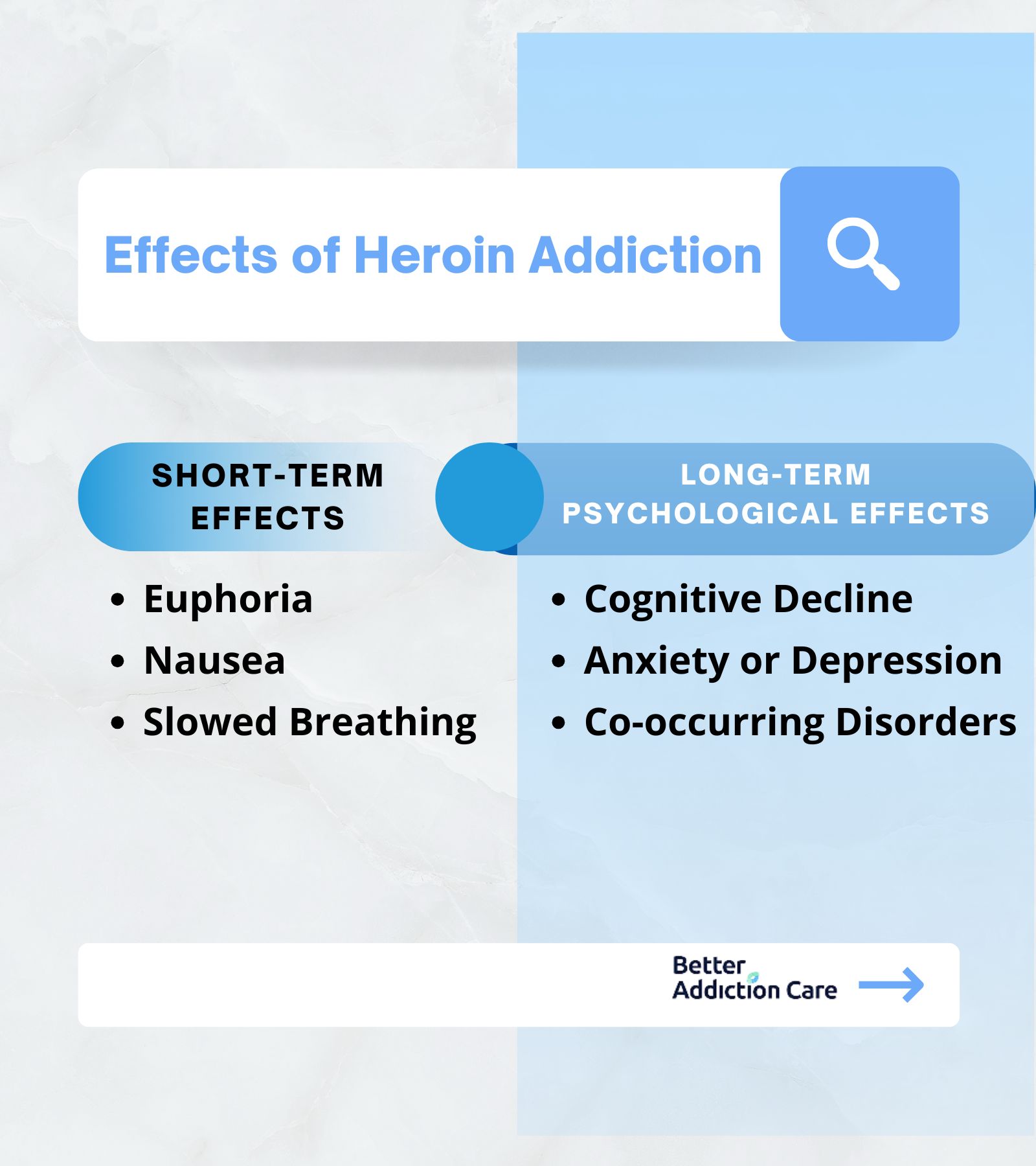
Short-Term Effects of Heroin Addiction
The short-term effects of heroin addiction are listed below:
-
Euphoria: Heroin use initially creates an intense feeling of pleasure and well-being, often referred to as a "rush." This occurs because heroin binds to opioid receptors in the brain, flooding the system with dopamine, the "feel-good" neurotransmitter.
-
Nausea: Many users experience nausea and vomiting shortly after using heroin, as the drug affects the digestive system and triggers a reaction in the brain's vomiting center.
-
Slowed Breathing: One of the most dangerous short-term effects is respiratory depression, where breathing slows down significantly. Slow breathing results in insufficient oxygen reaching the brain and other organs, leading to unconsciousness, coma, or even death in cases of overdose.
Long-Term Psychological Effects of Heroin Addiction
The long-term psychological effects of heroin addiction are listed below:
-
Cognitive Decline: Prolonged heroin use could impair cognitive functions such as memory, attention, and decision-making. The drug alters brain structure and chemistry, leading to difficulties in learning and problem-solving, which continue even after discontinuing use.
-
Anxiety or Depression: Heroin addiction often leads to chronic mental health issues like anxiety and depression. The brain's natural balance of mood-regulating chemicals is disrupted, making users more prone to emotional instability, sadness, and heightened anxiety when not using the drug.
-
Co-occurring Disorders: Many heroin users develop co-occurring mental health disorders, such as bipolar disorder, post-traumatic stress disorder (PTSD), or schizophrenia. These conditions complicate recovery and often require dual-diagnosis treatment to address both addiction and mental health simultaneously.
Relationship and Social Life Effects of Heroin Addiction
The relationship and social life effects of heroin addiction are listed below:
-
Strained Relationships: Heroin addiction often leads to tension and conflict with family members, friends, and partners. The user’s drug-seeking behavior, dishonesty, and emotional instability is able to erode trust and damage close relationships.
-
Social Isolation: As addiction progresses, individuals tend to withdraw from social activities and lose contact with friends who are not involved in drug use. Isolation is often a result of shame, guilt, or the overwhelming need to focus solely on obtaining and using heroin.
-
Job Loss: Addiction severely impacts work performance due to absenteeism, lack of focus, or behavioral issues. Many users struggle to hold down a job, leading to financial insecurity and contributing to the cycle of dependence.
-
Financial Strain: The cost of maintaining a heroin addiction is substantial, often leading individuals to deplete their savings, borrow money, or engage in illegal activities to fund their habit. Financial strain could further damage relationships and create long-term debt.
-
Legal Problems: Heroin addiction frequently leads to criminal behavior, such as theft or drug dealing, in order to support the habit. This could result in arrests, imprisonment, and a criminal record, making future employment and social reintegration more difficult.
How is Heroin Addiction Treated?
Heroin addiction can be treated through various methods, including medical detoxification, medications, behavioral therapies, long-term rehabilitation programs, and support groups.
These treatment options are listed below.
Medical Detoxification and Withdrawal Management
Detoxification is the process of safely removing heroin from the body while managing withdrawal symptoms. Detoxification typically takes 5-7 days in a medical setting. The advantage is that it addresses the physical aspect of addiction under professional supervision, but it does not treat psychological dependence, which requires further care.
Medications
Medications like methadone, buprenorphine, and naltrexone are used to manage cravings and withdrawal symptoms. Methadone and buprenorphine work by activating opioid receptors in the brain, reducing cravings without producing a high, while naltrexone blocks opioid receptors, preventing heroin from taking effect. Recovery time with medications varies, often requiring long-term management. Advantages include reducing relapse rates, while disadvantages include potential dependency on medications.
Behavioral Therapies
Contingency management, relapse prevention, and cognitive-behavioral therapy (CBT) showed moderate effectiveness across 34 well-controlled trials involving over 2,300 patients according to the study published by the National Library of Medicine written by Lissa Dutra. The approach was identified as the most effective method, while dropout rates were around one-third for participants in these treatments, compared to nearly 45% for control groups.
The analysis revealed that the efficacy of these therapies varies by substance. Behavioral therapy is typically part of a long-term recovery plan and lasts from weeks to months. The advantage is that it addresses the psychological aspects of addiction, though it requires a strong commitment from the patient.
Long-term Rehabilitation Programs
Inpatient or outpatient rehabilitation programs offer comprehensive care, including medical, psychological, and social support according to the study titled “Approaches to Treatment of Substance Abuse” published by WHO. These programs last from 30 days to several months, depending on the individual's needs. The advantage is the structured environment, which reduces access to drugs, but long-term commitment could be a challenge for some.
Support Groups
Support groups like Narcotics Anonymous (NA) provide perfect support to help individuals stay sober. These groups promote long-term recovery through shared experiences and a sense of community. Participation in support groups is typically lifelong. The advantage is ongoing support, while the downside is that it may not be sufficient without other forms of treatment.
What is the Heroin Withdrawal Process Like?
Heroin withdrawal is a challenging process that occurs when someone dependent on heroin stops using the drug, causing the body to react to the sudden absence of opioids. Symptoms could range from mild discomfort to severe physical and psychological distress. Common withdrawal symptoms include intense cravings for heroin, restlessness, body pain, nausea, sweating, and insomnia.
The early stage begins within 6 to 12 hours after the last dose, and people experience anxiety, muscle aches, and drug cravings. This is followed by the peak stage, occurring around 48 to 72 hours after the last use when symptoms intensify with severe nausea, vomiting, sweating, and abdominal cramps. The late stage, occurring after about a week, marks the start of symptom relief, though psychological effects such as cravings and mood swings may persist for weeks or months.
Attempting withdrawal without medical supervision could be risky and lead to complications like severe dehydration or relapse, which increases the likelihood of overdose. Safe withdrawal management, such as undergoing detox in a medical facility, helps manage symptoms with professional oversight and medications, ensuring a safer and more comfortable recovery process.
How Can You Prevent Heroin Relapse?
To prevent heroin relapse, you should enroll in aftercare programs, take relapse-prevention medications, opt for healthy lifestyle changes, and build a support system or network.
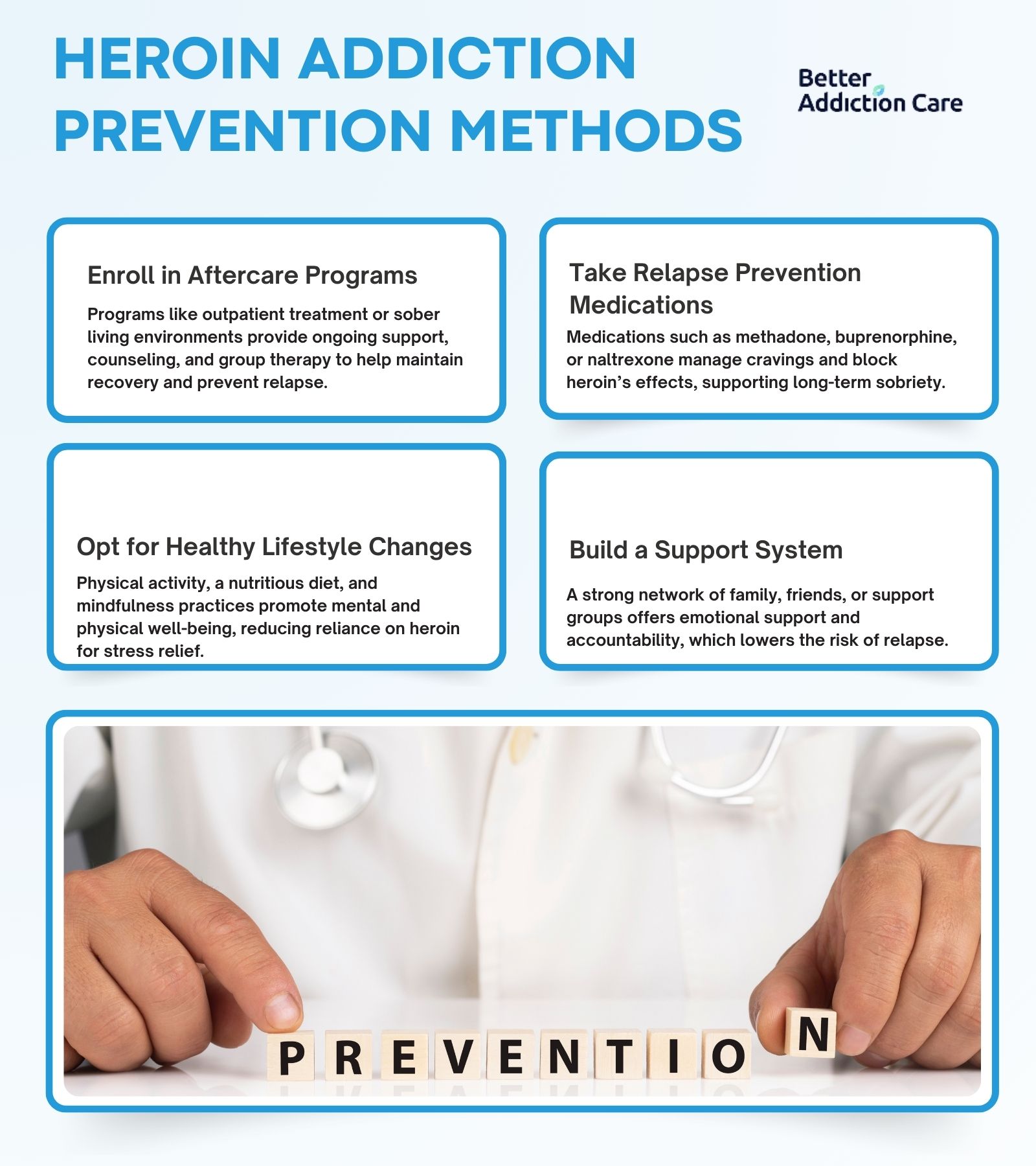
These prevention methods are listed below.
-
Enroll in Aftercare Programs: Aftercare programs, such as outpatient treatment or sober living environments, provide ongoing support and structured activities that help individuals stay focused on recovery after the initial rehabilitation process. These programs offer counseling, group therapy, and continuous monitoring to reduce the risk of relapse.
-
Take Relapse Prevention Medications: Medications like methadone, buprenorphine, or naltrexone help manage cravings and reduce withdrawal symptoms. By stabilizing the brain’s chemistry and blocking the effects of opioids, these medications offer a layer of protection against relapse.
-
Opt for Healthy Lifestyle Changes: Engaging in physical activities, adopting a nutritious diet, and practicing mindfulness or stress-management techniques boost mental and physical well-being. A healthy lifestyle creates a stable routine that reduces the likelihood of turning to heroin to cope with stress.
-
Build A Support System or Network: Surrounding yourself with family, friends, or support groups who understand your struggles and encourage sobriety is crucial. Strong relationships and community involvement provide emotional support and accountability, significantly lowering the chance of relapse.
What are the Risk Factors for Heroin Overdose?
The risk factors of heroin overdose are linked to the drug’s unpredictable potency and the user’s physical condition. One major risk factor for heroin overdose is tolerance. After taking a break from heroin, the body loses its ability to handle the same amount of the drug. If someone relapses and uses the same dose they used before, it causes an overdose. Another risk is using multiple drugs at the same time, especially mixing heroin with alcohol or benzodiazepines. The combination of heroin with alcohol or benzodiazepines slows down the central nervous system, making it hard to breathe and increasing the chances of overdose. Fentanyl, a very strong synthetic opioid often mixed with heroin, makes overdose even more likely because it's much more powerful than heroin on its own.
Overdose death rates are disproportionately higher in specific populations, particularly among non-Hispanic Black males aged 25-44, who saw a nearly 56% increase in overdose deaths from 2019 to 2020 according to the Centers for Disease Control and Prevention (CDC),. Hispanic and White individuals in the same age group have also experienced significant rises in overdose deaths, with rates of 41% and 28%, respectively.
How Does Heroin Addiction Compare to Other Drug Addictions?
Heroin addiction is more severe than many other drugs due to its intense physical dependence and higher overdose risk. Compared to crystal meth, hashish, and morphine, it poses greater health dangers and requires comprehensive treatment. The comparison of heroin addiction with the use of crystal meth, hashish, and morphine is described below.
Can heroin and crystal meth lead to mental health issues?
Yes, heroin and crystal meth addiction both lead to significant mental health issues. Heroin, an opioid, has sedative effects that often result in depression and lethargy. It creates euphoria by binding to opioid receptors, leading to dependence and severe withdrawal. Crystal meth, a synthetic stimulant, sharply increases dopamine levels, causing intense energy and pleasure followed by emotional crashes. The overstimulation results in aggression, paranoia, and psychosis. Heroin dampens the nervous system, crystal meth stimulates it. Despite the differences, both drugs disrupt the brain's reward system, creating a high risk for addiction and mental health disorders, highlighting the need for comprehensive treatment.
Does Heroin Have a Higher Potential for Addiction Compared to Hashish?
Yes, heroin has a higher potential for addiction compared to hashish. Heroin and hashish are two substances with distinct properties and effects on the body and mind. Heroin is an opioid derived from morphine that produces intense feelings of euphoria and pain relief by binding to opioid receptors in the brain. The possibility of euphoria is what makes heroin highly addictive. Hashish, which is a concentrated form of cannabis, contains higher levels of tetrahydrocannabinol (THC), the psychoactive compound that produces a relaxed state of mind and mild euphoria.
Heroin is generally considered to have a higher risk than hashish. The rapid start of heroin’s effects and the intense cravings it produces lead to physical dependence and severe withdrawal symptoms, making it more challenging to quit. Hashish addiction tends to have a lower potential for addiction due to its milder effects and the slower development of tolerance. Heroin and hashish affect the brain's reward system and lead to psychological dependence.
Do Morphine and Heroin Share a Similar Chemical Structure?
Yes, morphine and heroin share a similar chemical structure as both are derived from opium and classified as opioids. Morphine is a natural alkaloid used medically for pain relief, acting on opioid receptors to alleviate severe pain and produce euphoria. Heroin is a semi-synthetic opioid created from morphine, allowing it to cross the blood-brain barrier more quickly and produce a more intense euphoric effect.
Morphine and heroin are both opioids, their potential for addiction and user impact differs significantly. Morphine is prescribed for legitimate medical purposes, often leading to controlled use and reduced risk of morphine addiction. Heroin is commonly used recreationally, resulting in a higher risk of misuse and addiction due to its rapid effects and intense cravings. Both drugs cause physical dependence and withdrawal symptoms, heroin’s illegal status and context of use often lead to more severe addiction and health consequences.


